INF80025 - Business Info Systems Analysis: Review of Methodologies
VerifiedAdded on 2023/06/11
|11
|2970
|410
Report
AI Summary
This report summarizes and critiques various business systems analysis and design methodologies, including Organizational Metaphors, Hard System Thinking (HST), Soft System Thinking (SST), Soft Systems Methodology (SSM), ETHICS, and Agile System Development. It analyzes these methodologies in the context of an evolving organizational environment, particularly focusing on how HST and SST can address issues like skills gaps in job applications. The report also discusses how these methodologies can aid in problem-solving within organizations, using the example of an individual seeking a job at Clinical Healthcare Inc. The document emphasizes the importance of adapting to change and balancing technology, people, and organizational factors for effective business systems analysis. Desklib provides this document along with a wealth of study resources to support students in their academic pursuits.
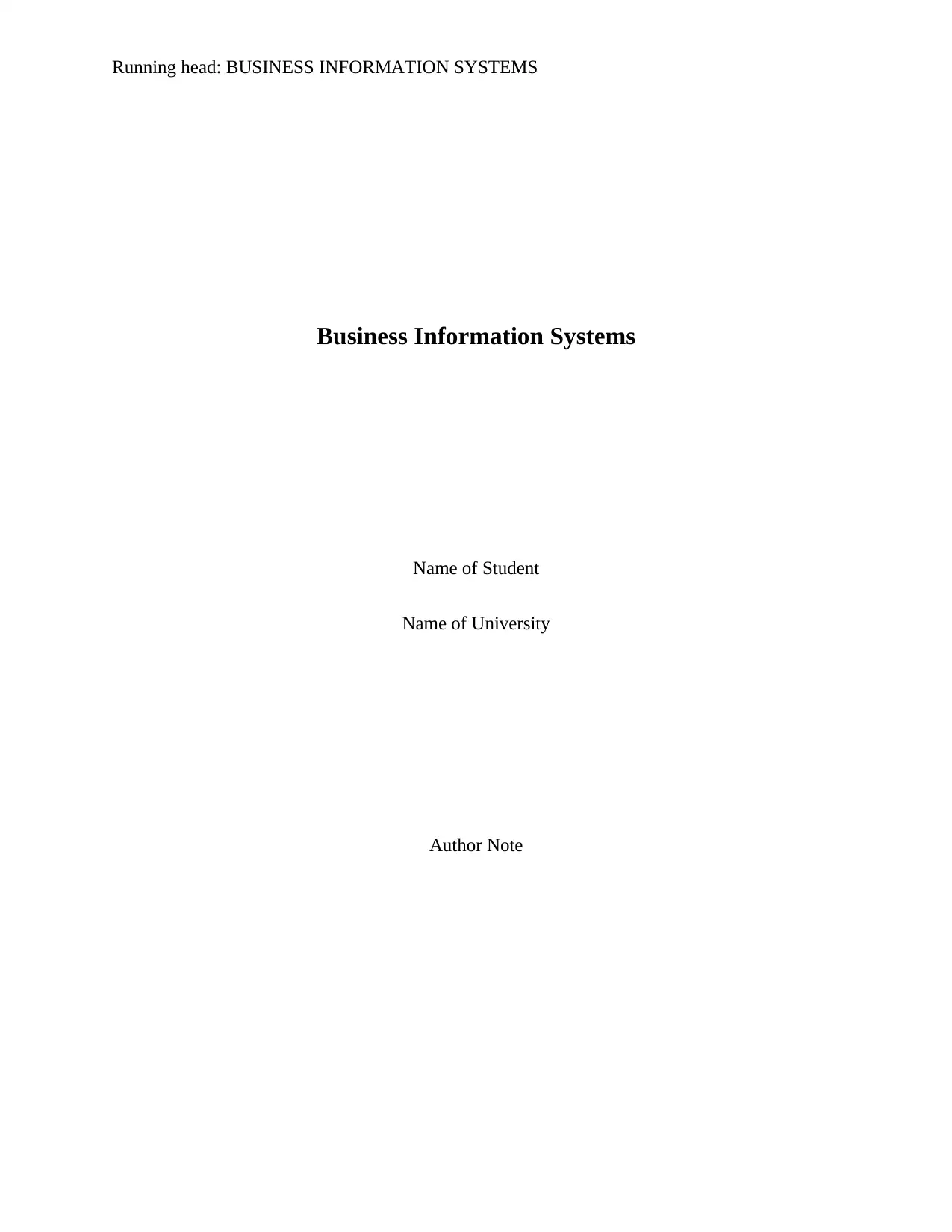
Running head: BUSINESS INFORMATION SYSTEMS
Business Information Systems
Name of Student
Name of University
Author Note
Business Information Systems
Name of Student
Name of University
Author Note
Paraphrase This Document
Need a fresh take? Get an instant paraphrase of this document with our AI Paraphraser
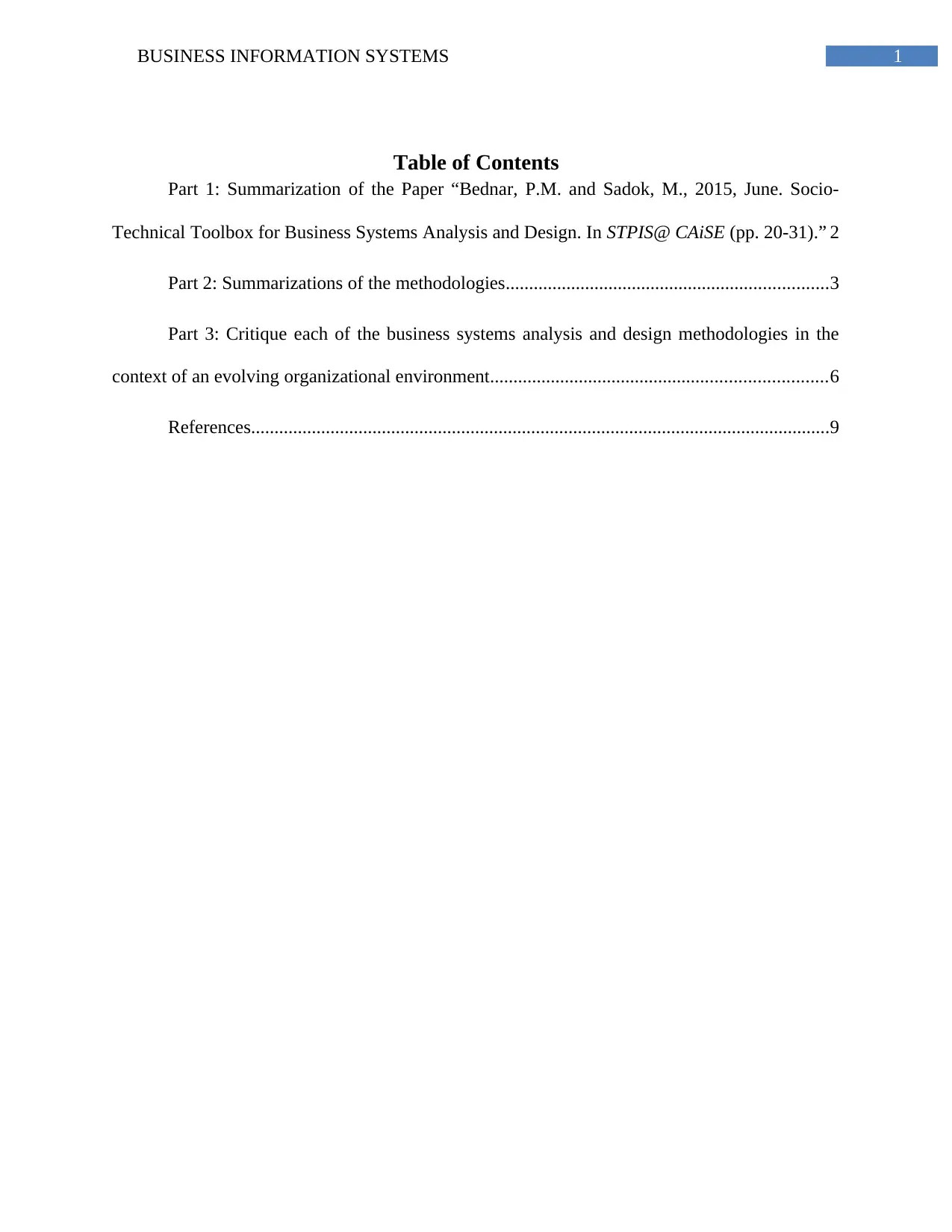
1BUSINESS INFORMATION SYSTEMS
Table of Contents
Part 1: Summarization of the Paper “Bednar, P.M. and Sadok, M., 2015, June. Socio-
Technical Toolbox for Business Systems Analysis and Design. In STPIS@ CAiSE (pp. 20-31).” 2
Part 2: Summarizations of the methodologies.....................................................................3
Part 3: Critique each of the business systems analysis and design methodologies in the
context of an evolving organizational environment........................................................................6
References............................................................................................................................9
Table of Contents
Part 1: Summarization of the Paper “Bednar, P.M. and Sadok, M., 2015, June. Socio-
Technical Toolbox for Business Systems Analysis and Design. In STPIS@ CAiSE (pp. 20-31).” 2
Part 2: Summarizations of the methodologies.....................................................................3
Part 3: Critique each of the business systems analysis and design methodologies in the
context of an evolving organizational environment........................................................................6
References............................................................................................................................9
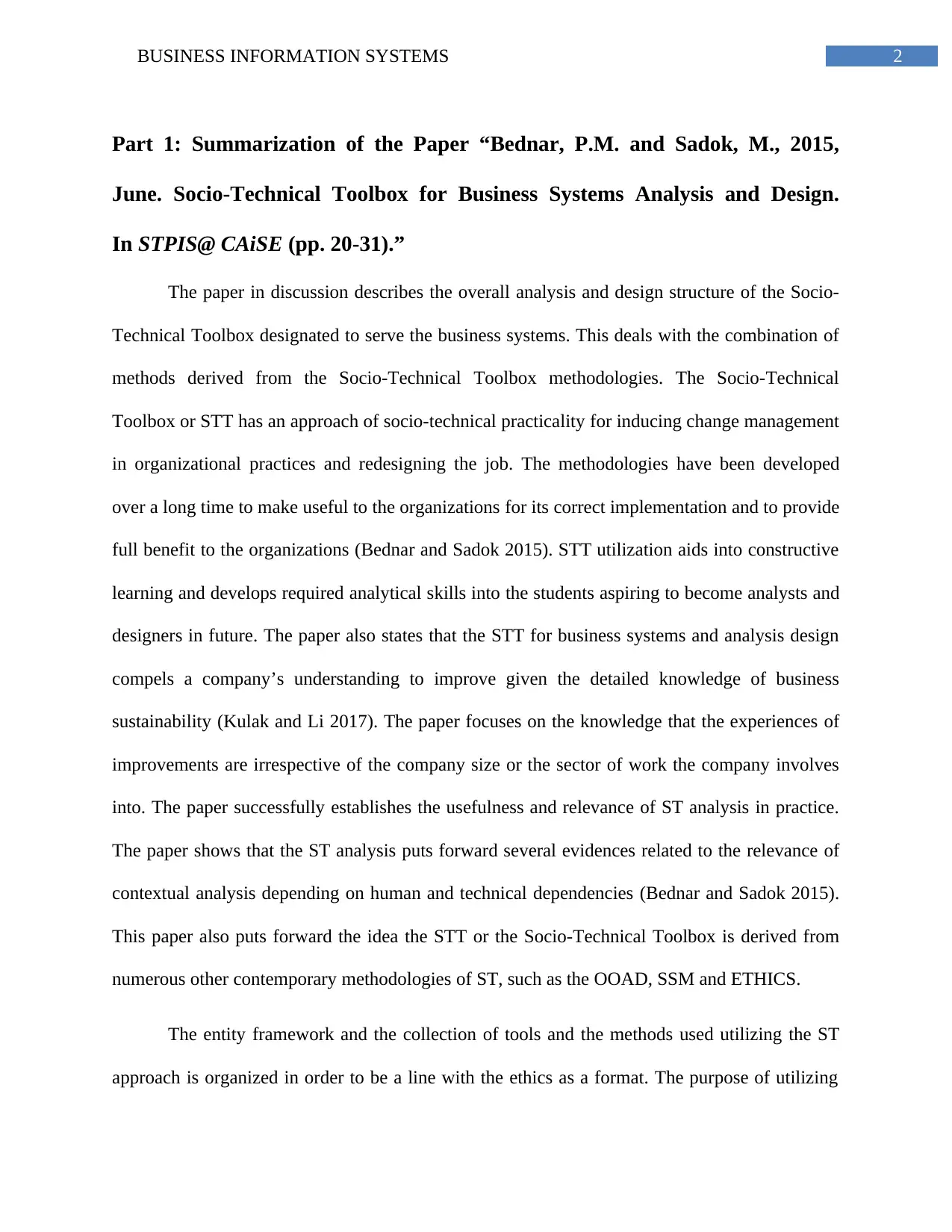
2BUSINESS INFORMATION SYSTEMS
Part 1: Summarization of the Paper “Bednar, P.M. and Sadok, M., 2015,
June. Socio-Technical Toolbox for Business Systems Analysis and Design.
In STPIS@ CAiSE (pp. 20-31).”
The paper in discussion describes the overall analysis and design structure of the Socio-
Technical Toolbox designated to serve the business systems. This deals with the combination of
methods derived from the Socio-Technical Toolbox methodologies. The Socio-Technical
Toolbox or STT has an approach of socio-technical practicality for inducing change management
in organizational practices and redesigning the job. The methodologies have been developed
over a long time to make useful to the organizations for its correct implementation and to provide
full benefit to the organizations (Bednar and Sadok 2015). STT utilization aids into constructive
learning and develops required analytical skills into the students aspiring to become analysts and
designers in future. The paper also states that the STT for business systems and analysis design
compels a company’s understanding to improve given the detailed knowledge of business
sustainability (Kulak and Li 2017). The paper focuses on the knowledge that the experiences of
improvements are irrespective of the company size or the sector of work the company involves
into. The paper successfully establishes the usefulness and relevance of ST analysis in practice.
The paper shows that the ST analysis puts forward several evidences related to the relevance of
contextual analysis depending on human and technical dependencies (Bednar and Sadok 2015).
This paper also puts forward the idea the STT or the Socio-Technical Toolbox is derived from
numerous other contemporary methodologies of ST, such as the OOAD, SSM and ETHICS.
The entity framework and the collection of tools and the methods used utilizing the ST
approach is organized in order to be a line with the ethics as a format. The purpose of utilizing
Part 1: Summarization of the Paper “Bednar, P.M. and Sadok, M., 2015,
June. Socio-Technical Toolbox for Business Systems Analysis and Design.
In STPIS@ CAiSE (pp. 20-31).”
The paper in discussion describes the overall analysis and design structure of the Socio-
Technical Toolbox designated to serve the business systems. This deals with the combination of
methods derived from the Socio-Technical Toolbox methodologies. The Socio-Technical
Toolbox or STT has an approach of socio-technical practicality for inducing change management
in organizational practices and redesigning the job. The methodologies have been developed
over a long time to make useful to the organizations for its correct implementation and to provide
full benefit to the organizations (Bednar and Sadok 2015). STT utilization aids into constructive
learning and develops required analytical skills into the students aspiring to become analysts and
designers in future. The paper also states that the STT for business systems and analysis design
compels a company’s understanding to improve given the detailed knowledge of business
sustainability (Kulak and Li 2017). The paper focuses on the knowledge that the experiences of
improvements are irrespective of the company size or the sector of work the company involves
into. The paper successfully establishes the usefulness and relevance of ST analysis in practice.
The paper shows that the ST analysis puts forward several evidences related to the relevance of
contextual analysis depending on human and technical dependencies (Bednar and Sadok 2015).
This paper also puts forward the idea the STT or the Socio-Technical Toolbox is derived from
numerous other contemporary methodologies of ST, such as the OOAD, SSM and ETHICS.
The entity framework and the collection of tools and the methods used utilizing the ST
approach is organized in order to be a line with the ethics as a format. The purpose of utilizing
⊘ This is a preview!⊘
Do you want full access?
Subscribe today to unlock all pages.

Trusted by 1+ million students worldwide
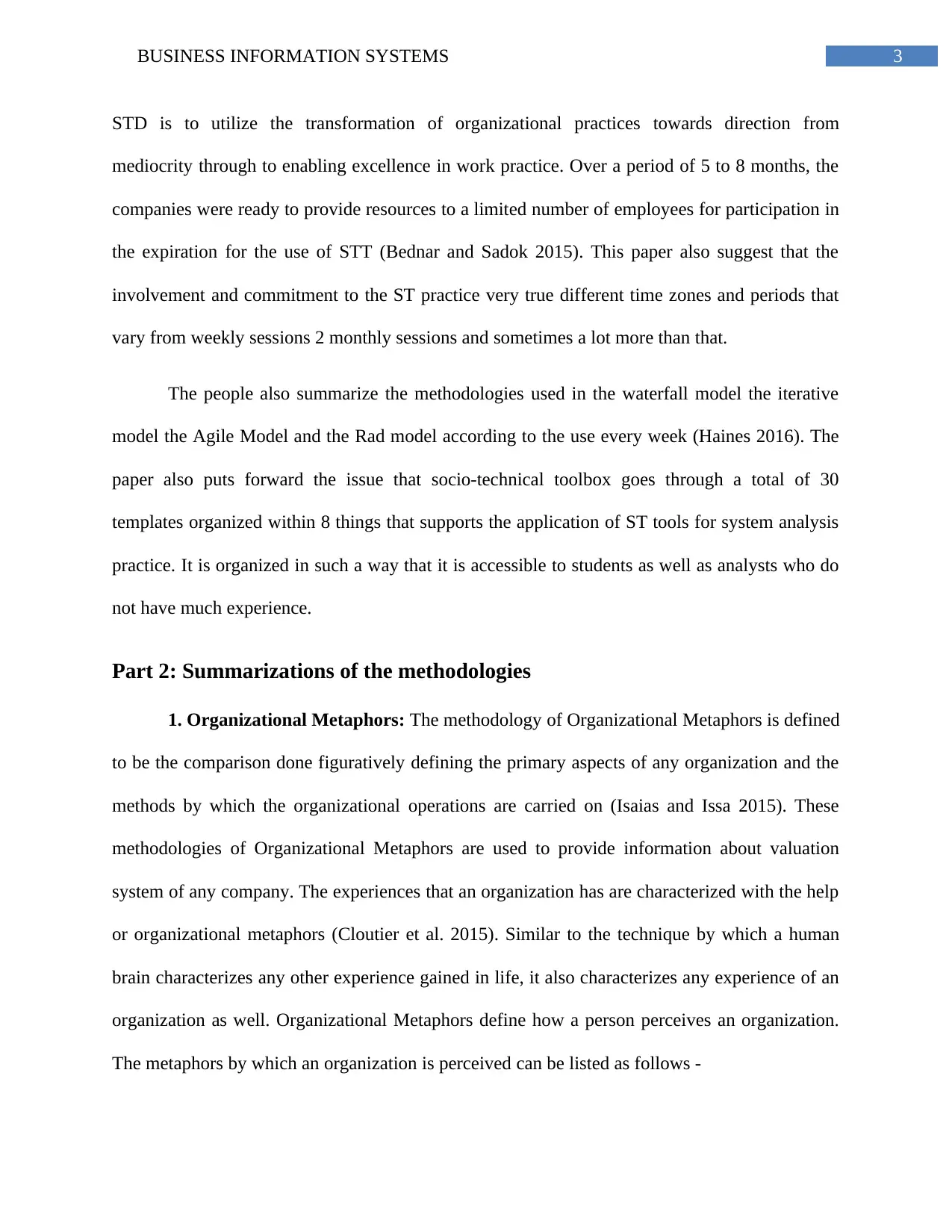
3BUSINESS INFORMATION SYSTEMS
STD is to utilize the transformation of organizational practices towards direction from
mediocrity through to enabling excellence in work practice. Over a period of 5 to 8 months, the
companies were ready to provide resources to a limited number of employees for participation in
the expiration for the use of STT (Bednar and Sadok 2015). This paper also suggest that the
involvement and commitment to the ST practice very true different time zones and periods that
vary from weekly sessions 2 monthly sessions and sometimes a lot more than that.
The people also summarize the methodologies used in the waterfall model the iterative
model the Agile Model and the Rad model according to the use every week (Haines 2016). The
paper also puts forward the issue that socio-technical toolbox goes through a total of 30
templates organized within 8 things that supports the application of ST tools for system analysis
practice. It is organized in such a way that it is accessible to students as well as analysts who do
not have much experience.
Part 2: Summarizations of the methodologies
1. Organizational Metaphors: The methodology of Organizational Metaphors is defined
to be the comparison done figuratively defining the primary aspects of any organization and the
methods by which the organizational operations are carried on (Isaias and Issa 2015). These
methodologies of Organizational Metaphors are used to provide information about valuation
system of any company. The experiences that an organization has are characterized with the help
or organizational metaphors (Cloutier et al. 2015). Similar to the technique by which a human
brain characterizes any other experience gained in life, it also characterizes any experience of an
organization as well. Organizational Metaphors define how a person perceives an organization.
The metaphors by which an organization is perceived can be listed as follows -
STD is to utilize the transformation of organizational practices towards direction from
mediocrity through to enabling excellence in work practice. Over a period of 5 to 8 months, the
companies were ready to provide resources to a limited number of employees for participation in
the expiration for the use of STT (Bednar and Sadok 2015). This paper also suggest that the
involvement and commitment to the ST practice very true different time zones and periods that
vary from weekly sessions 2 monthly sessions and sometimes a lot more than that.
The people also summarize the methodologies used in the waterfall model the iterative
model the Agile Model and the Rad model according to the use every week (Haines 2016). The
paper also puts forward the issue that socio-technical toolbox goes through a total of 30
templates organized within 8 things that supports the application of ST tools for system analysis
practice. It is organized in such a way that it is accessible to students as well as analysts who do
not have much experience.
Part 2: Summarizations of the methodologies
1. Organizational Metaphors: The methodology of Organizational Metaphors is defined
to be the comparison done figuratively defining the primary aspects of any organization and the
methods by which the organizational operations are carried on (Isaias and Issa 2015). These
methodologies of Organizational Metaphors are used to provide information about valuation
system of any company. The experiences that an organization has are characterized with the help
or organizational metaphors (Cloutier et al. 2015). Similar to the technique by which a human
brain characterizes any other experience gained in life, it also characterizes any experience of an
organization as well. Organizational Metaphors define how a person perceives an organization.
The metaphors by which an organization is perceived can be listed as follows -
Paraphrase This Document
Need a fresh take? Get an instant paraphrase of this document with our AI Paraphraser
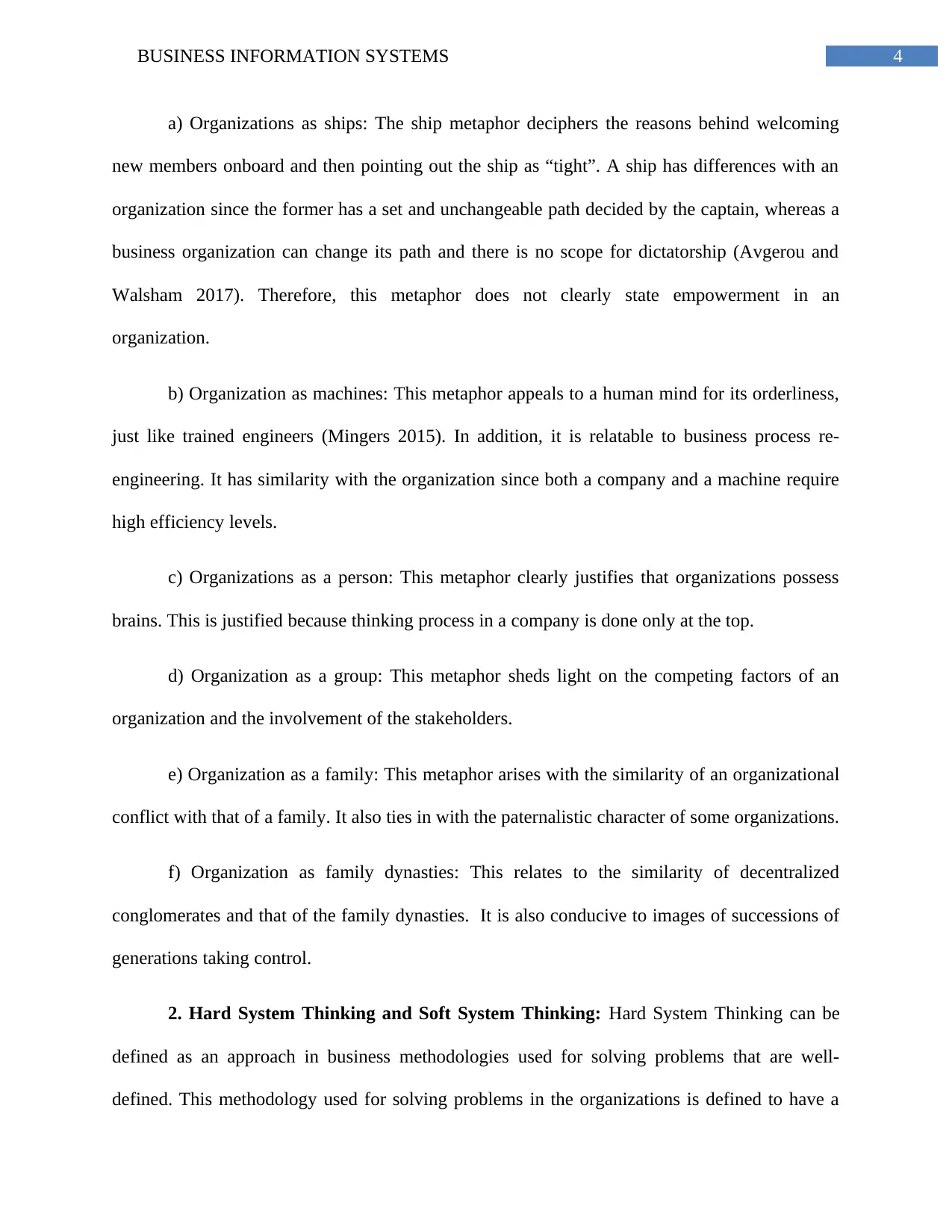
4BUSINESS INFORMATION SYSTEMS
a) Organizations as ships: The ship metaphor deciphers the reasons behind welcoming
new members onboard and then pointing out the ship as “tight”. A ship has differences with an
organization since the former has a set and unchangeable path decided by the captain, whereas a
business organization can change its path and there is no scope for dictatorship (Avgerou and
Walsham 2017). Therefore, this metaphor does not clearly state empowerment in an
organization.
b) Organization as machines: This metaphor appeals to a human mind for its orderliness,
just like trained engineers (Mingers 2015). In addition, it is relatable to business process re-
engineering. It has similarity with the organization since both a company and a machine require
high efficiency levels.
c) Organizations as a person: This metaphor clearly justifies that organizations possess
brains. This is justified because thinking process in a company is done only at the top.
d) Organization as a group: This metaphor sheds light on the competing factors of an
organization and the involvement of the stakeholders.
e) Organization as a family: This metaphor arises with the similarity of an organizational
conflict with that of a family. It also ties in with the paternalistic character of some organizations.
f) Organization as family dynasties: This relates to the similarity of decentralized
conglomerates and that of the family dynasties. It is also conducive to images of successions of
generations taking control.
2. Hard System Thinking and Soft System Thinking: Hard System Thinking can be
defined as an approach in business methodologies used for solving problems that are well-
defined. This methodology used for solving problems in the organizations is defined to have a
a) Organizations as ships: The ship metaphor deciphers the reasons behind welcoming
new members onboard and then pointing out the ship as “tight”. A ship has differences with an
organization since the former has a set and unchangeable path decided by the captain, whereas a
business organization can change its path and there is no scope for dictatorship (Avgerou and
Walsham 2017). Therefore, this metaphor does not clearly state empowerment in an
organization.
b) Organization as machines: This metaphor appeals to a human mind for its orderliness,
just like trained engineers (Mingers 2015). In addition, it is relatable to business process re-
engineering. It has similarity with the organization since both a company and a machine require
high efficiency levels.
c) Organizations as a person: This metaphor clearly justifies that organizations possess
brains. This is justified because thinking process in a company is done only at the top.
d) Organization as a group: This metaphor sheds light on the competing factors of an
organization and the involvement of the stakeholders.
e) Organization as a family: This metaphor arises with the similarity of an organizational
conflict with that of a family. It also ties in with the paternalistic character of some organizations.
f) Organization as family dynasties: This relates to the similarity of decentralized
conglomerates and that of the family dynasties. It is also conducive to images of successions of
generations taking control.
2. Hard System Thinking and Soft System Thinking: Hard System Thinking can be
defined as an approach in business methodologies used for solving problems that are well-
defined. This methodology used for solving problems in the organizations is defined to have a
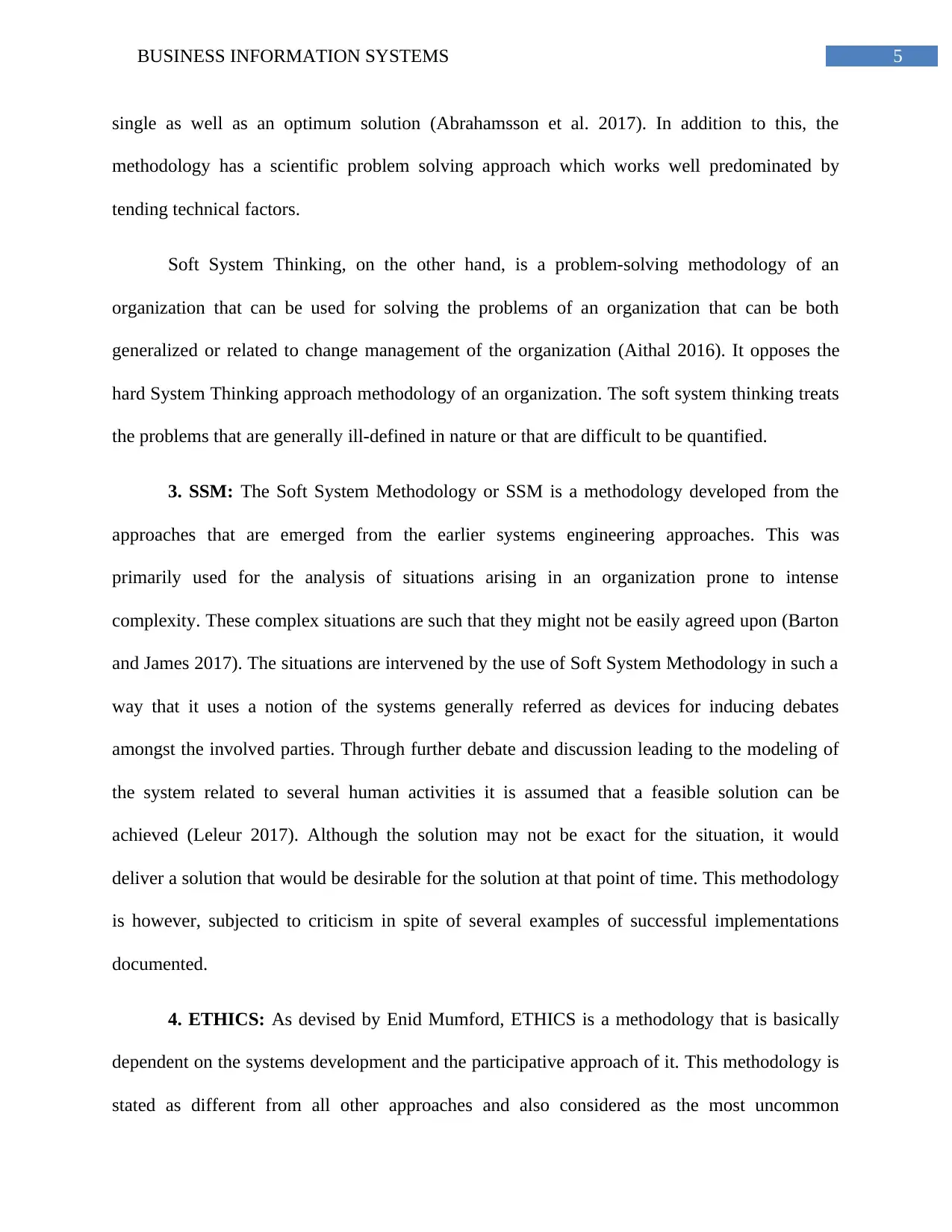
5BUSINESS INFORMATION SYSTEMS
single as well as an optimum solution (Abrahamsson et al. 2017). In addition to this, the
methodology has a scientific problem solving approach which works well predominated by
tending technical factors.
Soft System Thinking, on the other hand, is a problem-solving methodology of an
organization that can be used for solving the problems of an organization that can be both
generalized or related to change management of the organization (Aithal 2016). It opposes the
hard System Thinking approach methodology of an organization. The soft system thinking treats
the problems that are generally ill-defined in nature or that are difficult to be quantified.
3. SSM: The Soft System Methodology or SSM is a methodology developed from the
approaches that are emerged from the earlier systems engineering approaches. This was
primarily used for the analysis of situations arising in an organization prone to intense
complexity. These complex situations are such that they might not be easily agreed upon (Barton
and James 2017). The situations are intervened by the use of Soft System Methodology in such a
way that it uses a notion of the systems generally referred as devices for inducing debates
amongst the involved parties. Through further debate and discussion leading to the modeling of
the system related to several human activities it is assumed that a feasible solution can be
achieved (Leleur 2017). Although the solution may not be exact for the situation, it would
deliver a solution that would be desirable for the solution at that point of time. This methodology
is however, subjected to criticism in spite of several examples of successful implementations
documented.
4. ETHICS: As devised by Enid Mumford, ETHICS is a methodology that is basically
dependent on the systems development and the participative approach of it. This methodology is
stated as different from all other approaches and also considered as the most uncommon
single as well as an optimum solution (Abrahamsson et al. 2017). In addition to this, the
methodology has a scientific problem solving approach which works well predominated by
tending technical factors.
Soft System Thinking, on the other hand, is a problem-solving methodology of an
organization that can be used for solving the problems of an organization that can be both
generalized or related to change management of the organization (Aithal 2016). It opposes the
hard System Thinking approach methodology of an organization. The soft system thinking treats
the problems that are generally ill-defined in nature or that are difficult to be quantified.
3. SSM: The Soft System Methodology or SSM is a methodology developed from the
approaches that are emerged from the earlier systems engineering approaches. This was
primarily used for the analysis of situations arising in an organization prone to intense
complexity. These complex situations are such that they might not be easily agreed upon (Barton
and James 2017). The situations are intervened by the use of Soft System Methodology in such a
way that it uses a notion of the systems generally referred as devices for inducing debates
amongst the involved parties. Through further debate and discussion leading to the modeling of
the system related to several human activities it is assumed that a feasible solution can be
achieved (Leleur 2017). Although the solution may not be exact for the situation, it would
deliver a solution that would be desirable for the solution at that point of time. This methodology
is however, subjected to criticism in spite of several examples of successful implementations
documented.
4. ETHICS: As devised by Enid Mumford, ETHICS is a methodology that is basically
dependent on the systems development and the participative approach of it. This methodology is
stated as different from all other approaches and also considered as the most uncommon
⊘ This is a preview!⊘
Do you want full access?
Subscribe today to unlock all pages.

Trusted by 1+ million students worldwide
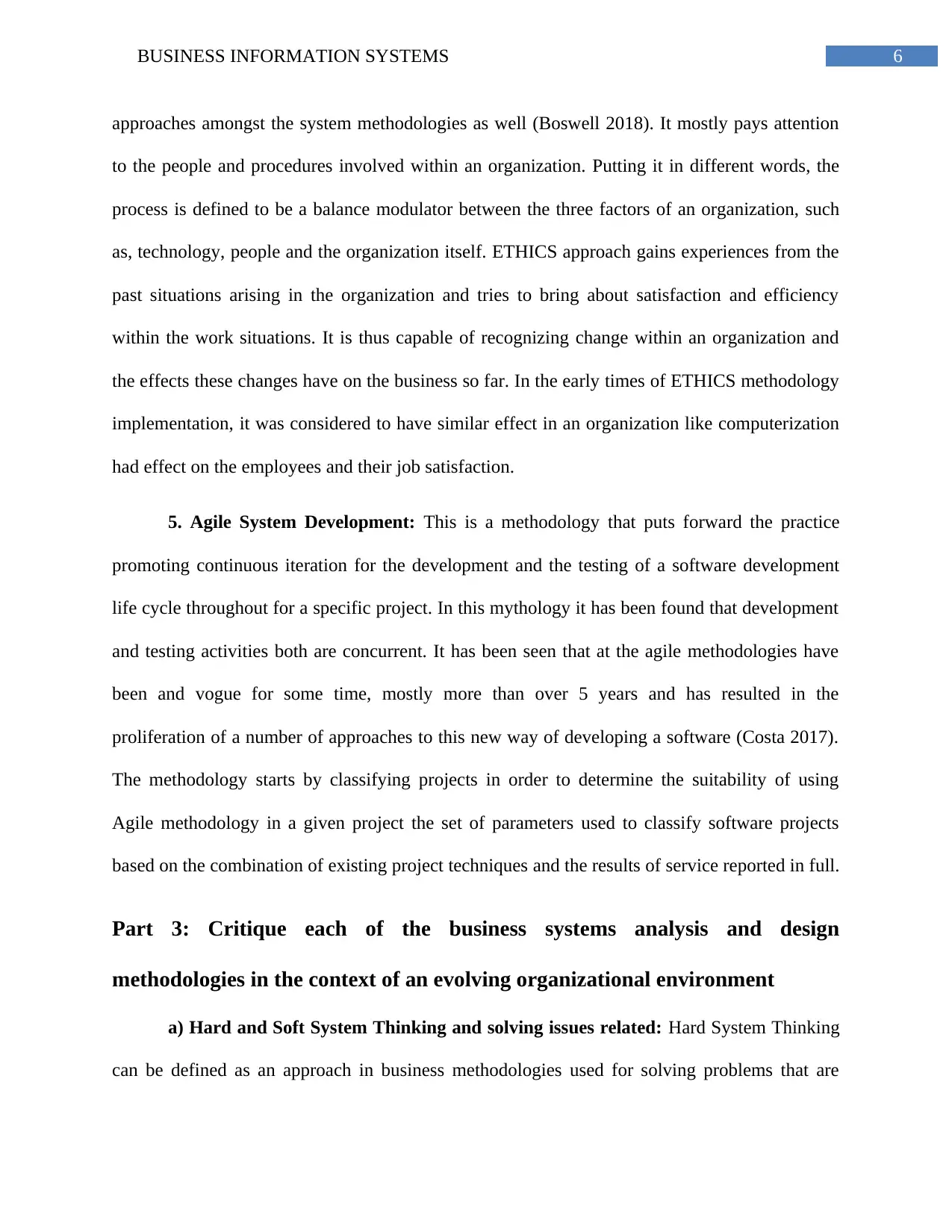
6BUSINESS INFORMATION SYSTEMS
approaches amongst the system methodologies as well (Boswell 2018). It mostly pays attention
to the people and procedures involved within an organization. Putting it in different words, the
process is defined to be a balance modulator between the three factors of an organization, such
as, technology, people and the organization itself. ETHICS approach gains experiences from the
past situations arising in the organization and tries to bring about satisfaction and efficiency
within the work situations. It is thus capable of recognizing change within an organization and
the effects these changes have on the business so far. In the early times of ETHICS methodology
implementation, it was considered to have similar effect in an organization like computerization
had effect on the employees and their job satisfaction.
5. Agile System Development: This is a methodology that puts forward the practice
promoting continuous iteration for the development and the testing of a software development
life cycle throughout for a specific project. In this mythology it has been found that development
and testing activities both are concurrent. It has been seen that at the agile methodologies have
been and vogue for some time, mostly more than over 5 years and has resulted in the
proliferation of a number of approaches to this new way of developing a software (Costa 2017).
The methodology starts by classifying projects in order to determine the suitability of using
Agile methodology in a given project the set of parameters used to classify software projects
based on the combination of existing project techniques and the results of service reported in full.
Part 3: Critique each of the business systems analysis and design
methodologies in the context of an evolving organizational environment
a) Hard and Soft System Thinking and solving issues related: Hard System Thinking
can be defined as an approach in business methodologies used for solving problems that are
approaches amongst the system methodologies as well (Boswell 2018). It mostly pays attention
to the people and procedures involved within an organization. Putting it in different words, the
process is defined to be a balance modulator between the three factors of an organization, such
as, technology, people and the organization itself. ETHICS approach gains experiences from the
past situations arising in the organization and tries to bring about satisfaction and efficiency
within the work situations. It is thus capable of recognizing change within an organization and
the effects these changes have on the business so far. In the early times of ETHICS methodology
implementation, it was considered to have similar effect in an organization like computerization
had effect on the employees and their job satisfaction.
5. Agile System Development: This is a methodology that puts forward the practice
promoting continuous iteration for the development and the testing of a software development
life cycle throughout for a specific project. In this mythology it has been found that development
and testing activities both are concurrent. It has been seen that at the agile methodologies have
been and vogue for some time, mostly more than over 5 years and has resulted in the
proliferation of a number of approaches to this new way of developing a software (Costa 2017).
The methodology starts by classifying projects in order to determine the suitability of using
Agile methodology in a given project the set of parameters used to classify software projects
based on the combination of existing project techniques and the results of service reported in full.
Part 3: Critique each of the business systems analysis and design
methodologies in the context of an evolving organizational environment
a) Hard and Soft System Thinking and solving issues related: Hard System Thinking
can be defined as an approach in business methodologies used for solving problems that are
Paraphrase This Document
Need a fresh take? Get an instant paraphrase of this document with our AI Paraphraser
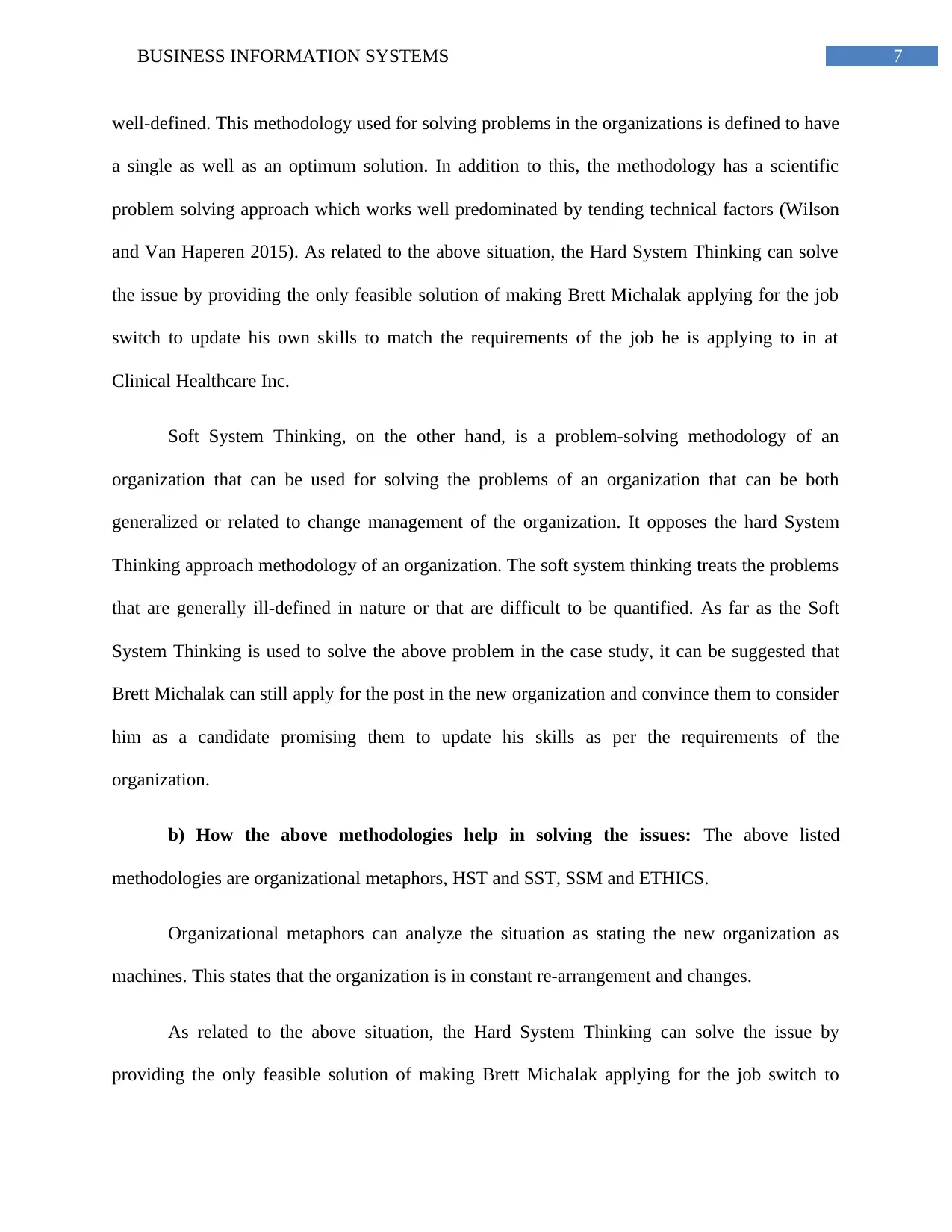
7BUSINESS INFORMATION SYSTEMS
well-defined. This methodology used for solving problems in the organizations is defined to have
a single as well as an optimum solution. In addition to this, the methodology has a scientific
problem solving approach which works well predominated by tending technical factors (Wilson
and Van Haperen 2015). As related to the above situation, the Hard System Thinking can solve
the issue by providing the only feasible solution of making Brett Michalak applying for the job
switch to update his own skills to match the requirements of the job he is applying to in at
Clinical Healthcare Inc.
Soft System Thinking, on the other hand, is a problem-solving methodology of an
organization that can be used for solving the problems of an organization that can be both
generalized or related to change management of the organization. It opposes the hard System
Thinking approach methodology of an organization. The soft system thinking treats the problems
that are generally ill-defined in nature or that are difficult to be quantified. As far as the Soft
System Thinking is used to solve the above problem in the case study, it can be suggested that
Brett Michalak can still apply for the post in the new organization and convince them to consider
him as a candidate promising them to update his skills as per the requirements of the
organization.
b) How the above methodologies help in solving the issues: The above listed
methodologies are organizational metaphors, HST and SST, SSM and ETHICS.
Organizational metaphors can analyze the situation as stating the new organization as
machines. This states that the organization is in constant re-arrangement and changes.
As related to the above situation, the Hard System Thinking can solve the issue by
providing the only feasible solution of making Brett Michalak applying for the job switch to
well-defined. This methodology used for solving problems in the organizations is defined to have
a single as well as an optimum solution. In addition to this, the methodology has a scientific
problem solving approach which works well predominated by tending technical factors (Wilson
and Van Haperen 2015). As related to the above situation, the Hard System Thinking can solve
the issue by providing the only feasible solution of making Brett Michalak applying for the job
switch to update his own skills to match the requirements of the job he is applying to in at
Clinical Healthcare Inc.
Soft System Thinking, on the other hand, is a problem-solving methodology of an
organization that can be used for solving the problems of an organization that can be both
generalized or related to change management of the organization. It opposes the hard System
Thinking approach methodology of an organization. The soft system thinking treats the problems
that are generally ill-defined in nature or that are difficult to be quantified. As far as the Soft
System Thinking is used to solve the above problem in the case study, it can be suggested that
Brett Michalak can still apply for the post in the new organization and convince them to consider
him as a candidate promising them to update his skills as per the requirements of the
organization.
b) How the above methodologies help in solving the issues: The above listed
methodologies are organizational metaphors, HST and SST, SSM and ETHICS.
Organizational metaphors can analyze the situation as stating the new organization as
machines. This states that the organization is in constant re-arrangement and changes.
As related to the above situation, the Hard System Thinking can solve the issue by
providing the only feasible solution of making Brett Michalak applying for the job switch to
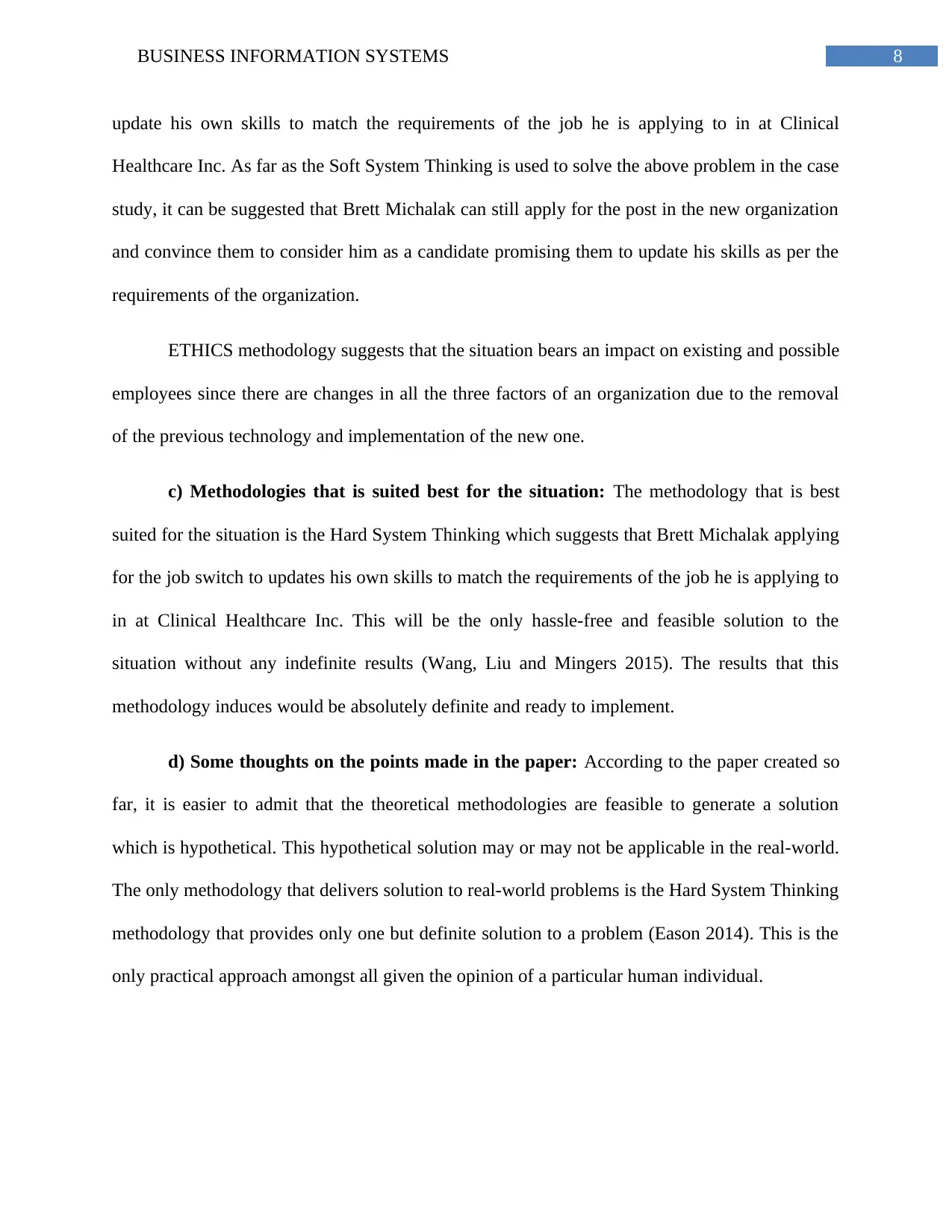
8BUSINESS INFORMATION SYSTEMS
update his own skills to match the requirements of the job he is applying to in at Clinical
Healthcare Inc. As far as the Soft System Thinking is used to solve the above problem in the case
study, it can be suggested that Brett Michalak can still apply for the post in the new organization
and convince them to consider him as a candidate promising them to update his skills as per the
requirements of the organization.
ETHICS methodology suggests that the situation bears an impact on existing and possible
employees since there are changes in all the three factors of an organization due to the removal
of the previous technology and implementation of the new one.
c) Methodologies that is suited best for the situation: The methodology that is best
suited for the situation is the Hard System Thinking which suggests that Brett Michalak applying
for the job switch to updates his own skills to match the requirements of the job he is applying to
in at Clinical Healthcare Inc. This will be the only hassle-free and feasible solution to the
situation without any indefinite results (Wang, Liu and Mingers 2015). The results that this
methodology induces would be absolutely definite and ready to implement.
d) Some thoughts on the points made in the paper: According to the paper created so
far, it is easier to admit that the theoretical methodologies are feasible to generate a solution
which is hypothetical. This hypothetical solution may or may not be applicable in the real-world.
The only methodology that delivers solution to real-world problems is the Hard System Thinking
methodology that provides only one but definite solution to a problem (Eason 2014). This is the
only practical approach amongst all given the opinion of a particular human individual.
update his own skills to match the requirements of the job he is applying to in at Clinical
Healthcare Inc. As far as the Soft System Thinking is used to solve the above problem in the case
study, it can be suggested that Brett Michalak can still apply for the post in the new organization
and convince them to consider him as a candidate promising them to update his skills as per the
requirements of the organization.
ETHICS methodology suggests that the situation bears an impact on existing and possible
employees since there are changes in all the three factors of an organization due to the removal
of the previous technology and implementation of the new one.
c) Methodologies that is suited best for the situation: The methodology that is best
suited for the situation is the Hard System Thinking which suggests that Brett Michalak applying
for the job switch to updates his own skills to match the requirements of the job he is applying to
in at Clinical Healthcare Inc. This will be the only hassle-free and feasible solution to the
situation without any indefinite results (Wang, Liu and Mingers 2015). The results that this
methodology induces would be absolutely definite and ready to implement.
d) Some thoughts on the points made in the paper: According to the paper created so
far, it is easier to admit that the theoretical methodologies are feasible to generate a solution
which is hypothetical. This hypothetical solution may or may not be applicable in the real-world.
The only methodology that delivers solution to real-world problems is the Hard System Thinking
methodology that provides only one but definite solution to a problem (Eason 2014). This is the
only practical approach amongst all given the opinion of a particular human individual.
⊘ This is a preview!⊘
Do you want full access?
Subscribe today to unlock all pages.

Trusted by 1+ million students worldwide
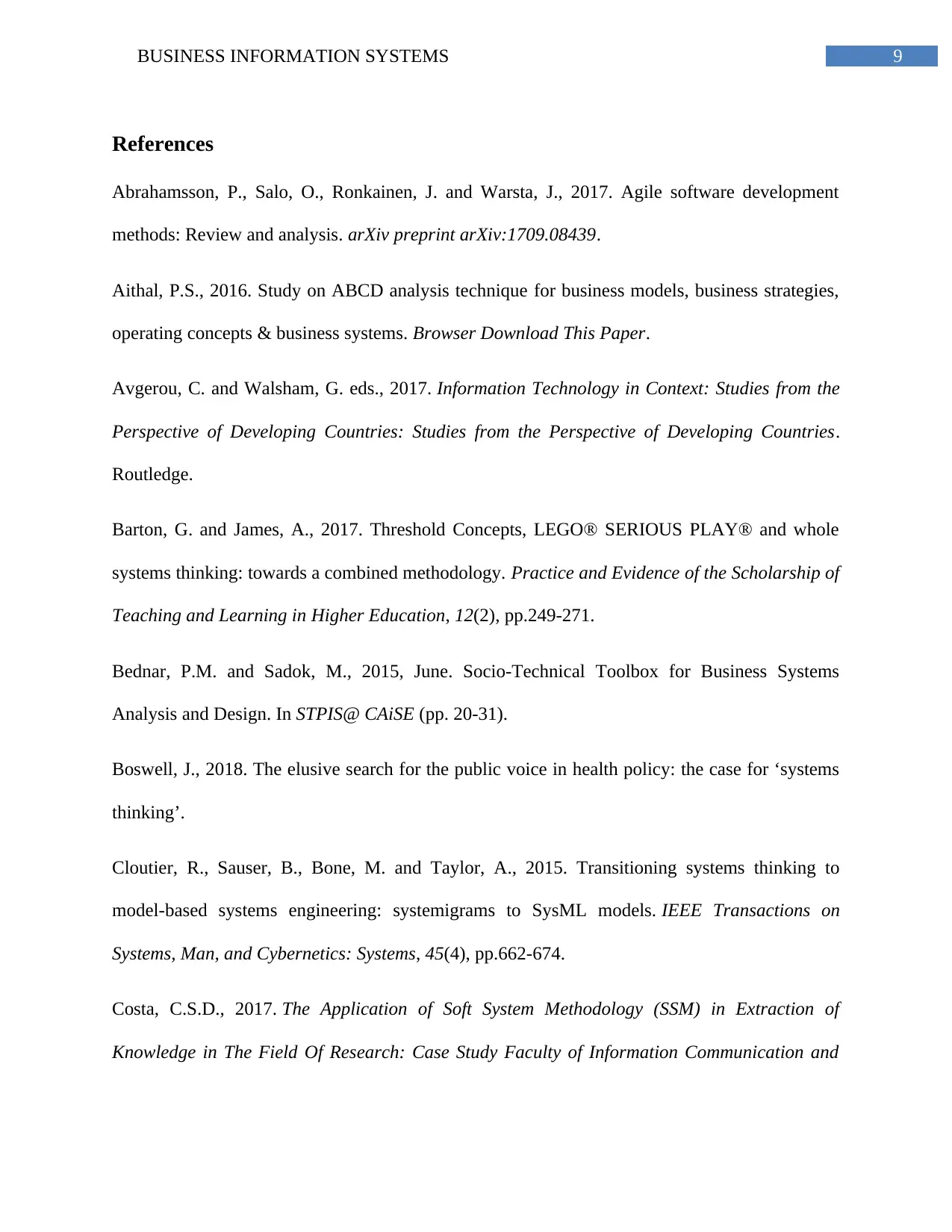
9BUSINESS INFORMATION SYSTEMS
References
Abrahamsson, P., Salo, O., Ronkainen, J. and Warsta, J., 2017. Agile software development
methods: Review and analysis. arXiv preprint arXiv:1709.08439.
Aithal, P.S., 2016. Study on ABCD analysis technique for business models, business strategies,
operating concepts & business systems. Browser Download This Paper.
Avgerou, C. and Walsham, G. eds., 2017. Information Technology in Context: Studies from the
Perspective of Developing Countries: Studies from the Perspective of Developing Countries.
Routledge.
Barton, G. and James, A., 2017. Threshold Concepts, LEGO® SERIOUS PLAY® and whole
systems thinking: towards a combined methodology. Practice and Evidence of the Scholarship of
Teaching and Learning in Higher Education, 12(2), pp.249-271.
Bednar, P.M. and Sadok, M., 2015, June. Socio-Technical Toolbox for Business Systems
Analysis and Design. In STPIS@ CAiSE (pp. 20-31).
Boswell, J., 2018. The elusive search for the public voice in health policy: the case for ‘systems
thinking’.
Cloutier, R., Sauser, B., Bone, M. and Taylor, A., 2015. Transitioning systems thinking to
model-based systems engineering: systemigrams to SysML models. IEEE Transactions on
Systems, Man, and Cybernetics: Systems, 45(4), pp.662-674.
Costa, C.S.D., 2017. The Application of Soft System Methodology (SSM) in Extraction of
Knowledge in The Field Of Research: Case Study Faculty of Information Communication and
References
Abrahamsson, P., Salo, O., Ronkainen, J. and Warsta, J., 2017. Agile software development
methods: Review and analysis. arXiv preprint arXiv:1709.08439.
Aithal, P.S., 2016. Study on ABCD analysis technique for business models, business strategies,
operating concepts & business systems. Browser Download This Paper.
Avgerou, C. and Walsham, G. eds., 2017. Information Technology in Context: Studies from the
Perspective of Developing Countries: Studies from the Perspective of Developing Countries.
Routledge.
Barton, G. and James, A., 2017. Threshold Concepts, LEGO® SERIOUS PLAY® and whole
systems thinking: towards a combined methodology. Practice and Evidence of the Scholarship of
Teaching and Learning in Higher Education, 12(2), pp.249-271.
Bednar, P.M. and Sadok, M., 2015, June. Socio-Technical Toolbox for Business Systems
Analysis and Design. In STPIS@ CAiSE (pp. 20-31).
Boswell, J., 2018. The elusive search for the public voice in health policy: the case for ‘systems
thinking’.
Cloutier, R., Sauser, B., Bone, M. and Taylor, A., 2015. Transitioning systems thinking to
model-based systems engineering: systemigrams to SysML models. IEEE Transactions on
Systems, Man, and Cybernetics: Systems, 45(4), pp.662-674.
Costa, C.S.D., 2017. The Application of Soft System Methodology (SSM) in Extraction of
Knowledge in The Field Of Research: Case Study Faculty of Information Communication and
Paraphrase This Document
Need a fresh take? Get an instant paraphrase of this document with our AI Paraphraser
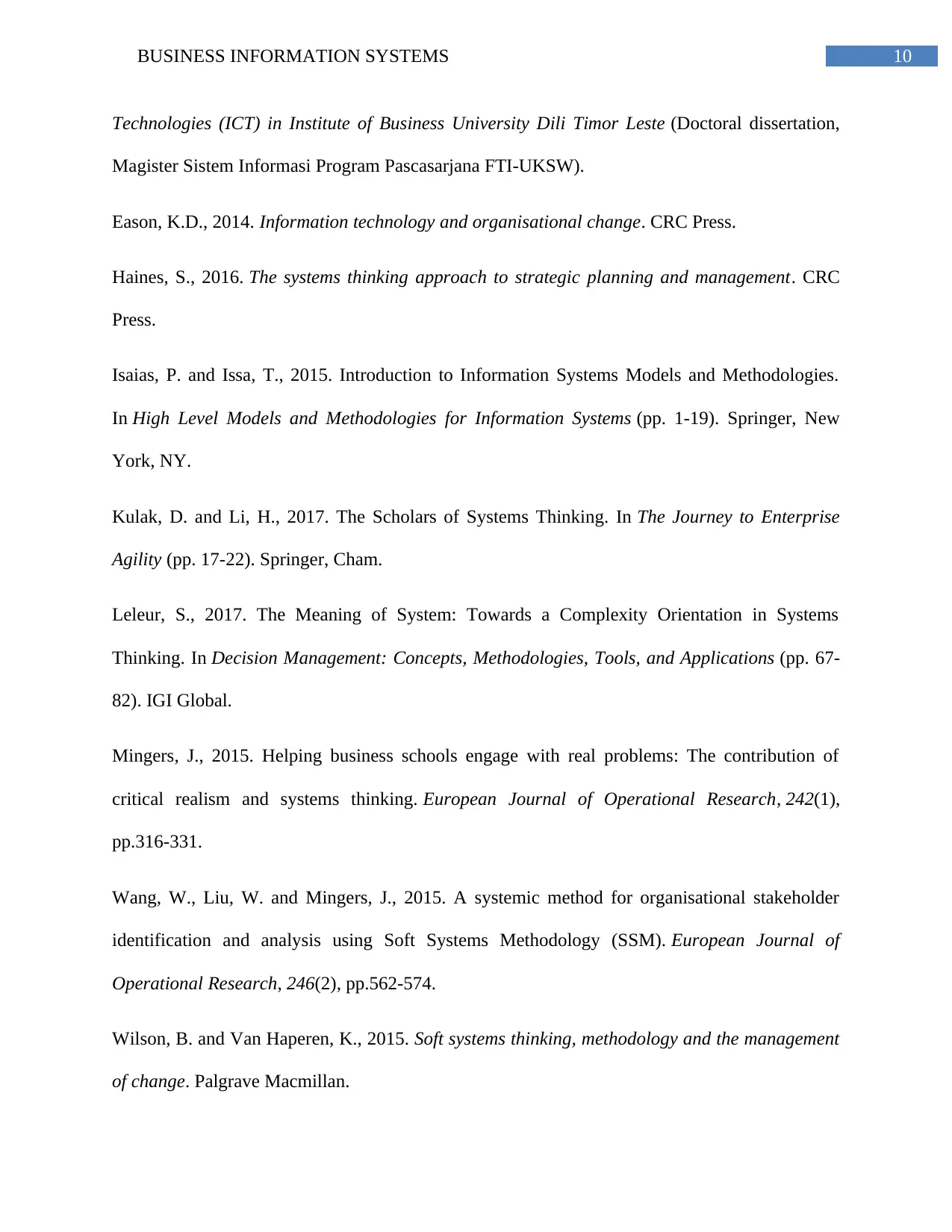
10BUSINESS INFORMATION SYSTEMS
Technologies (ICT) in Institute of Business University Dili Timor Leste (Doctoral dissertation,
Magister Sistem Informasi Program Pascasarjana FTI-UKSW).
Eason, K.D., 2014. Information technology and organisational change. CRC Press.
Haines, S., 2016. The systems thinking approach to strategic planning and management. CRC
Press.
Isaias, P. and Issa, T., 2015. Introduction to Information Systems Models and Methodologies.
In High Level Models and Methodologies for Information Systems (pp. 1-19). Springer, New
York, NY.
Kulak, D. and Li, H., 2017. The Scholars of Systems Thinking. In The Journey to Enterprise
Agility (pp. 17-22). Springer, Cham.
Leleur, S., 2017. The Meaning of System: Towards a Complexity Orientation in Systems
Thinking. In Decision Management: Concepts, Methodologies, Tools, and Applications (pp. 67-
82). IGI Global.
Mingers, J., 2015. Helping business schools engage with real problems: The contribution of
critical realism and systems thinking. European Journal of Operational Research, 242(1),
pp.316-331.
Wang, W., Liu, W. and Mingers, J., 2015. A systemic method for organisational stakeholder
identification and analysis using Soft Systems Methodology (SSM). European Journal of
Operational Research, 246(2), pp.562-574.
Wilson, B. and Van Haperen, K., 2015. Soft systems thinking, methodology and the management
of change. Palgrave Macmillan.
Technologies (ICT) in Institute of Business University Dili Timor Leste (Doctoral dissertation,
Magister Sistem Informasi Program Pascasarjana FTI-UKSW).
Eason, K.D., 2014. Information technology and organisational change. CRC Press.
Haines, S., 2016. The systems thinking approach to strategic planning and management. CRC
Press.
Isaias, P. and Issa, T., 2015. Introduction to Information Systems Models and Methodologies.
In High Level Models and Methodologies for Information Systems (pp. 1-19). Springer, New
York, NY.
Kulak, D. and Li, H., 2017. The Scholars of Systems Thinking. In The Journey to Enterprise
Agility (pp. 17-22). Springer, Cham.
Leleur, S., 2017. The Meaning of System: Towards a Complexity Orientation in Systems
Thinking. In Decision Management: Concepts, Methodologies, Tools, and Applications (pp. 67-
82). IGI Global.
Mingers, J., 2015. Helping business schools engage with real problems: The contribution of
critical realism and systems thinking. European Journal of Operational Research, 242(1),
pp.316-331.
Wang, W., Liu, W. and Mingers, J., 2015. A systemic method for organisational stakeholder
identification and analysis using Soft Systems Methodology (SSM). European Journal of
Operational Research, 246(2), pp.562-574.
Wilson, B. and Van Haperen, K., 2015. Soft systems thinking, methodology and the management
of change. Palgrave Macmillan.
1 out of 11
Your All-in-One AI-Powered Toolkit for Academic Success.
+13062052269
info@desklib.com
Available 24*7 on WhatsApp / Email
![[object Object]](/_next/static/media/star-bottom.7253800d.svg)
Unlock your academic potential
Copyright © 2020–2025 A2Z Services. All Rights Reserved. Developed and managed by ZUCOL.
